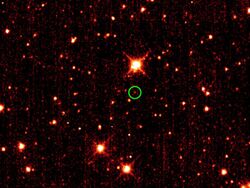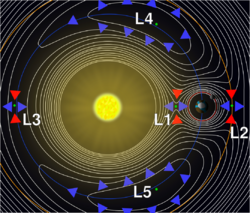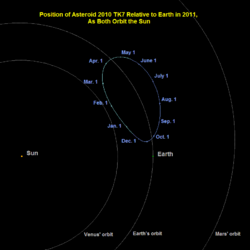Astronomy:2010 TK7
 Asteroid 2010 TK7 (circled in green) in image from the WISE spacecraft | |
| Discovery[1] | |
|---|---|
| Discovered by | WISE spacecraft |
| Discovery site | LEO, polar orbit |
| Discovery date | 1 October 2010 |
| Designations | |
| Minor planet category |
|
| Orbital characteristics[2] | |
| Epoch 13 January 2016 (JD 2457400.5) | |
| Uncertainty parameter 0 | |
| Observation arc | 768 days (2.10 yr) |
| |{{{apsis}}}|helion}} | 1.1903 astronomical unit|AU (178.07 Gm) |
| |{{{apsis}}}|helion}} | 0.80918 AU (121.052 Gm) |
| 0.99972 AU (149.556 Gm) | |
| Eccentricity | 0.19059 |
| Orbital period | 1.00 yr (365.10 d) |
| Average Orbital speed | 29.8 km/s[lower-alpha 1] |
| Mean anomaly | 354.14° |
| Mean motion | 0° 59m 9.672s / day |
| Inclination | 20.890° |
| Longitude of ascending node | 96.498° |
| 45.927° | |
| Earth MOID | 0.0837911 AU (12.53497 Gm) |
| Physical characteristics | |
| Mean diameter | 379±123 m[2] |
| Geometric albedo | 0.059±0.049[2] |
| Apparent magnitude | 20.8 (when near Earth) to 23.6 |
| Absolute magnitude (H) | 20.8[2] |
2010 TK7 is a sub-kilometer Near-Earth asteroid and the first Earth trojan discovered; it precedes Earth in its orbit around the Sun.[4][5] Trojan objects are most easily conceived as orbiting at a Lagrangian point, a dynamically stable location (where the combined gravitational force acts through the Sun's and Earth's barycenter) 60 degrees ahead of or behind a massive orbiting body, in a type of 1:1 orbital resonance. In reality, they oscillate around such a point. Such objects had previously been observed in the orbits of Mars, Jupiter, Neptune, and the Saturnian moons Tethys and Dione.
2010 TK7 has a diameter of about 300 meters (1,000 ft).[6] Its path oscillates about the Sun–Earth L4 Lagrangian point (60 degrees ahead of Earth), shuttling between its closest approach to Earth and its closest approach to the L3 point (180 degrees from Earth).
The asteroid was discovered in October 2010 by the NEOWISE team of astronomers using NASA's Wide-field Infrared Survey Explorer (WISE).[7]
Discovery
WISE, a space telescope launched into Earth orbit in December 2009, imaged 2010 TK7 in October 2010 while carrying out a program to scan the entire sky from January 2010 to February 2011. Spotting an asteroid sharing Earth's orbit is normally difficult from the ground, because their potential locations are generally in the daytime sky.[8] After follow-up work at the University of Hawaii and the Canada–France–Hawaii Telescope, its orbit was evaluated on 21 May 2011 and the trojan character of its motion was published in July 2011. The orbital information was published in the journal Nature by Paul Wiegert of the University of Western Ontario, Martin Connors of Athabasca University and Christian Veillet, the executive director of the Canada–France–Hawaii Telescope.[4][8]
Physical and orbital characteristics
2010 TK7 has an absolute magnitude of luminosity (determinable because of its known location) of about 20.8.[2] Based on an assumed albedo of 0.1, its estimated diameter is about 300 meters.[4] No spectral data are yet available to shed light on its composition. 2010 TK7 would exert a surface gravitational force of less than 1⁄20,000 that of Earth.
At the time of discovery, the asteroid orbited the Sun with a period of 365.389 days, close to Earth's 365.256 days. As long as it remains in 1:1 resonance with Earth, its average period over long time intervals will exactly equal that of Earth. On its eccentric (e = 0.191) orbit, 2010 TK7's distance from the Sun varies annually from 0.81 AU to 1.19 AU.[4] It orbits in a plane inclined about 21 degrees to the plane of the ecliptic.
Trojans do not orbit right at Lagrangian points but oscillate in tadpole-shaped loops around them (as viewed in a corotating reference frame in which the planet and Lagrangian points are stationary); 2010 TK7 traverses its loop over a period of 395 years.[lower-alpha 2][4] 2010 TK7's loop is so elongated that it sometimes travels nearly to the opposite side of the Sun with respect to Earth. Its movements do not bring it any closer to Earth than 20 million kilometers (12.4 million miles), which is more than 50 times the distance to the Moon. 2010 TK7 was at the near-Earth end of its tadpole in 2010–2011,[4] which facilitated its discovery.
2010 TK7's orbit has a chaotic character, making long-range predictions difficult. Prior to 500 AD, it may have been oscillating about the L5 Lagrangian point (60 degrees behind Earth), before jumping to L4 via L3. Short-term unstable libration about L3, and transitions to horseshoe orbits are also possible.[4] Newer calculations based on an improved orbit determination confirm these results.[9]
Accessibility from Earth

Because Earth trojans share Earth's orbit and have little gravity of their own, less energy might be needed to reach them than the Moon, even though they are much more distant. However, 2010 TK7 is not an energetically attractive target for a space mission because of its orbital inclination:[10] It moves so far above and below Earth's orbit that the required change in velocity for a spacecraft to match its trajectory coming from Earth's would be 9.4 km/s, whereas some other near-Earth asteroids require less than 4 km/s.[4]
During the 5 December 2012 Earth close approach of 0.197 astronomical unit|AU (29,500,000 km; 18,300,000 mi),[11] the asteroid had an apparent magnitude of about 21.[12]
See also
- 2020 XL5, the second Earth trojan discovered
- Claimed moons of Earth
- Provisional designation in astronomy, the naming convention used for astronomical objects immediately following their discovery
Notes
- ↑ v = 42.1219 √1/0.9989 − 0.5/0.9989.
- ↑ Because of its orbital inclination and eccentricity, 2010 TK7's position relative to Earth is actually a complicated, tightly coiled spiral; however, if its average position relative to Earth over a year is represented by a single point, that point will follow the tadpole loop.
References
- ↑ "2010 TK7 Orbit". Minor Planet Center. http://www.minorplanetcenter.net/db_search/show_object?object_id=2010+TK7.
- ↑ 2.0 2.1 2.2 2.3 2.4 2.5 "JPL Small-Body Database Browser: 2010 TK7". http://ssd.jpl.nasa.gov/sbdb.cgi?sstr=3548081.
- ↑ WayBack Machine 2013 Epoch@MPC
- ↑ 4.0 4.1 4.2 4.3 4.4 4.5 4.6 4.7 Connors, Martin; Wiegert, Paul; Veillet, Christian (27 July 2011). "Earth's Trojan asteroid". Nature 475 (7357): 481–483. doi:10.1038/nature10233. PMID 21796207. Bibcode: 2011Natur.475..481C.
- ↑ "NASA's WISE Mission Finds First Trojan Asteroid Sharing Earth's Orbit". NASA. 27 July 2011. http://www.nasa.gov/mission_pages/WISE/news/wise20110727.html.
- ↑ Choi, Charles Q. (27 July 2011). "First Asteroid Companion of Earth Discovered at Last". Space.com. http://www.space.com/12443-earth-asteroid-companion-discovered-2010-tk7.html.
- ↑ Keys, Sonia (2010-10-07). "MPEC 2010-T45 : 2010 TK7". IAU Minor Planet Center. http://www.minorplanetcenter.net/mpec/K10/K10T45.html.
- ↑ 8.0 8.1 "Earth's first Trojan asteroid: 2010 TK7". Astro.uwo.ca. 27 July 2011. http://www.astro.uwo.ca/~wiegert/2010TK7/.
- ↑ de la Fuente Marcos, Carlos; de la Fuente Marcos, Raúl (18 February 2021). "Transient Terrestrial Trojans: Comparative Short-term Dynamical Evolution of 2010 TK7 and 2020 XL5". Research Notes of the American Astronomical Society 5 (2): 29. doi:10.3847/2515-5172/abe6ad. Bibcode: 2021RNAAS...5...29D.
- ↑ "Found at last: First Earth companion asteroid". NBC News. 27 July 2011. http://www.nbcnews.com/id/43914196.
- ↑ "JPL Close-Approach Data: (2010 TK7)". http://ssd.jpl.nasa.gov/sbdb.cgi?sstr=2010TK7;cad=1#cad.
- ↑ "AstDyS 2010TK7 Ephemerides for 2012". Department of Mathematics, University of Pisa, Italy. https://newton.spacedys.com/astdys/index.php?pc=1.1.3.1&n=2010TK7&oc=500&y0=2012&m0=11&d0=01&h0=0&mi0=0&y1=2013&m1=1&d1=1&h1=0&mi1=0&ti=1.0&tiu=days.
- Amos, Jonathan (2011-07-28). "Trojan asteroid seen in Earth's orbit by Wise telescope". BBC News. https://www.bbc.co.uk/news/science-environment-14307987.
External links
- MPC Database entry for 2010 TK7
- NASA animation of its motion
- Alternate NASA animation of 2010 TK7 motion
- 2010 TK7 at NeoDyS-2, Near Earth Objects—Dynamic Site
- Ephemeris · Obs prediction · Orbital info · MOID · Proper elements · Obs info · Close · Physical info · NEOCC
- 2010 TK7 at ESA–space situational awareness
- 2010 TK7 at the JPL Small-Body Database
 |






